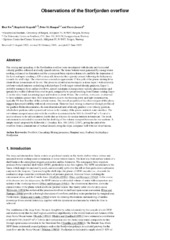| dc.description.abstract | The mixing and spreading of the Storfjorden overflow were investigated with density and horizontal velocity profiles collected at closely spaced stations. The dense bottom water generated by strong winter cooling, enhanced ice formation and the consequent brine rejection drains into and fills the depression of the fjord and upon reaching a 120-m deep sill, descends like a gravity current following the bathymetry towards the shelf edge. The observations covered an approximate 37-km path of the plume starting from about 68km downstream of the sill. The plume is identified as two layers: a dense layer 1 with relatively uniform vertical structure underlying a thicker layer 2 with larger vertical density gradients. Layer 1, probably remnants from earlier overflows, almost maintains its temperature–salinity characteristics and spreads to a width of about 6 km over its path, comparable to spread resulting from Ekman veering. Layer 2, on the other hand, is a mixing layer and widens to about 16 km. The overflow, in its core, is observed to have salinities greater than 34.9, temperatures close to the freezing point, and light transmissivity typically 5% less than that of the ambient waters. The overall properties of the observed part of the plume suggest dynamical stability with weak entrainment. However local mixing is observed through profiles of the gradient Richardson number, the non-dimensional ratio of density gradient over velocity gradient, which show portions with supercritical values in the vicinity of the plume– ambient water interface. The net volume transport associated with the overflow is estimated to be 0.06 Sv (Sv≡106m3 s-1) out of a section closest to the sill and almost double that as it leaves the section furthest downstream. The weak entrainment is estimated to account for the doubling of the volume transport between the two sections. A simple model proposed by Killworth (J. Geophys. Res. 106 (2001) 22267), giving the path of the overflow from a constant rate of vertical descent along the slope, compares well with our observations. | en_US |
